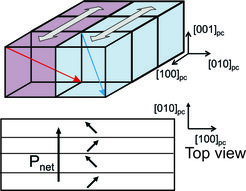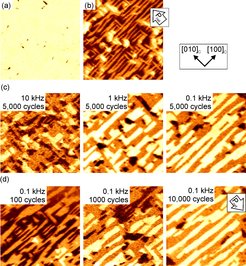
Figure 1:
Schematics of possible orientations of the polarization vector in 71° stripe ferroelectric domains of BiFeO3 epitaxial films, yielding a well-defined in-plane projection of the net polarization.
Schematics of possible orientations of the polarization vector in 71° stripe ferroelectric domains of BiFeO3 epitaxial films, yielding a well-defined in-plane projection of the net polarization.
© MPI -FKF

Figure 2:
(a) VPFM phase and (b) LPFM phase signal of as-grown state of the BiFeO3/SrRuO3/SrTiO3(100) sample. The arrow in (b) indicates the direction of the net in-plane polarization. (c)LPFM images of Cu/BiFeO3/SrRuO3/SrTiO3 capacitors switched 5,000 times at different frequencies and (d) capacitors switched at 0.1 kHz with different numbers of cycles. After 10,000 cycles the direction of net in-plane polarization is inverted compared to the as-grown state. All images are scans of 6×6 µm² areas.
(a) VPFM phase and (b) LPFM phase signal of as-grown state of the BiFeO3/SrRuO3/SrTiO3(100) sample. The arrow in (b) indicates the direction of the net in-plane polarization. (c)LPFM images of Cu/BiFeO3/SrRuO3/SrTiO3 capacitors switched 5,000 times at different frequencies and (d) capacitors switched at 0.1 kHz with different numbers of cycles. After 10,000 cycles the direction of net in-plane polarization is inverted compared to the as-grown state. All images are scans of 6×6 µm² areas.
© MPI - FKF

